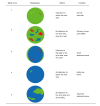Endoscopic ultrasound elastography for solid pancreatic lesions
- PMID: 29085561
- PMCID: PMC5648993
- DOI: 10.4253/wjge.v9.i10.506
Endoscopic ultrasound elastography for solid pancreatic lesions
Abstract
Elastography is one of technologies assisting diagnosis of solid pancreatic lesions (SPL). This technology has been previously used for measuring the stiffness of various organs based on a principle of "harder the lesions, higher chance for malignancy". Two elastography techniques; strain and shear wave elastography, are available. For endoscopic ultrasound (EUS), only the former is existing. To interpret results of EUS elastography for SPL, 3 methods are used: (1) pattern recognition; (2) strain ratio; and (3) strain histogram. Based on results of existing studies, these 3 techniques provide high sensitivity but low to moderate specificity and accuracy rate. This review will summarize all available information in order to update current situation of using elastography for an evaluation of SPLs to readers.
Keywords: Chronic pancreatitis; Elastography; Endoscopic ultrasound; Pancreatic cancer; Solid pancreatic lesions.
Conflict of interest statement
Conflict-of-interest statement: The authors revealed no conflict of interest in relation to this review.
Figures





References
-
- Ueno E, Tohno E, Soeda S, Asaoka Y, Itoh K, Bamber JC, Blaszçzyk M, Davey J, Mckinna JA. Dynamic tests in real-time breast echography. Ultrasound Med Biol. 1988;14 Suppl 1:53–57. - PubMed
-
- Ophir J, Céspedes I, Ponnekanti H, Yazdi Y, Li X. Elastography: a quantitative method for imaging the elasticity of biological tissues. Ultrason Imaging. 1991;13:111–134. - PubMed
-
- Shiina T, Nitta N, Ueno E, Bamber JC. Real time tissue elasticity imaging using the combined autocorrelation method. J Med Ultrason (2001) 2002;29:119–128. - PubMed
-
- Giovannini M, Hookey LC, Bories E, Pesenti C, Monges G, Delpero JR. Endoscopic ultrasound elastography: the first step towards virtual biopsy? Preliminary results in 49 patients. Endoscopy. 2006;38:344–348. - PubMed
-
- Hirooka Y, Kuwahara T, Irisawa A, Itokawa F, Uchida H, Sasahira N, Kawada N, Itoh Y, Shiina T. JSUM ultrasound elastography practice guidelines: pancreas. J Med Ultrason (2001) 2015;42:151–174. - PubMed
Publication types
LinkOut - more resources
Full Text Sources
Other Literature Sources

